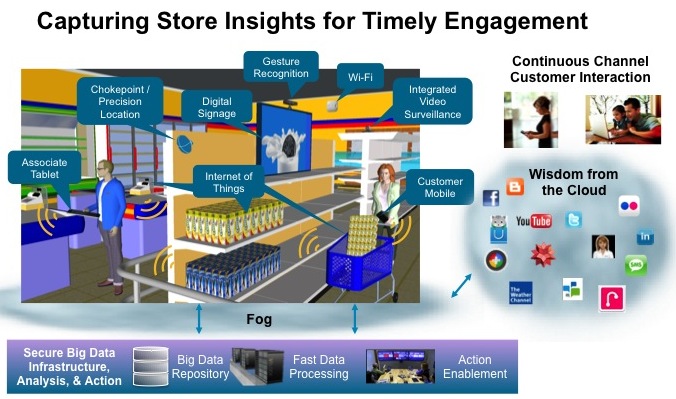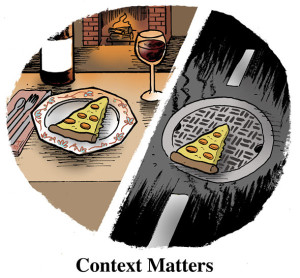In the early days of e-commerce, retailers were scrambling to build websites that mimicked their retail stores so that customers would easily understand how a shopping website worked. So features we’re built and named like their real world counterparts: virtual “shopping carts”, shop by department, etc.
We’ve been talking a lot here at CloudTags about the reversal of that concept today: the idea of the next generation of brick and mortar retail stores being engineered more like websites.
Cisco wrote earlier this year about the future of the physical store being one powered by big data and internet of things devices, along with this illustration of what that might look like:

What this illustration doesn’t explicitly show is what the retailer could DO with all of this data. Its easy enough to add a few pages or a new layout to a website, but what if you could do the same with a physical space? What if stores we’re incredibly modular and could dynamically change based on who walks in the door, what inventory is most popular, what shoppers look at and pick up the most? Maybe that means a combination of physical products on shelves and digital screens next to them showing every color combination and style variant. Or it could mean actual store departments that change configuration based on day of the week (weekends or sale events have different aisle and rack configurations than a regular weekday to accommodate larger crowds).
Now, all of this might sound like something out of science fiction, but in fact much of this technology already exists. For example, this company (http://www.wallsforms.com/products/shop-in-a-box) makes modular retail displays meant for temporary store setups like increasingly popular “pop-up” shops. All that’s missing is the granular data to inform exactly how to configure the store and which products to put where. Which is where in-store browsing intent data comes into play.
When we say “in-store intent data”, we mean something like this: with today’s technology, a retailer who integrated all the data being pushed around in their store could know the point of entry, footpath, dwell time, expressed interest, and purchase data tied to a specific demo/psychographic – the same types of data points the e-commerce sites have been tracking for years.

As customers increasingly use mobile devices in store, eventually interacting directly with products, those devices all have a slew of sensors that can tell retailers so much about behavior. GPS, indoor positioning systems, all the latest tech that can pinpoint where customers are… is practically worthless for interacting with those customers if you don’t have some contextual or intent data. Retailers would like to know where customers are walking, stopping, etc in their stores - their activity data. But it’s much more useful to know WHY they’re taking those actions, i.e. intent data.
But gathering intent data is not as easy as it may sound. Its not enough to just track customers through out their shopping experience and model that data, retailers need to engage their shoppers with a meaningful experience that uses that data to give them something of value. Because the best intent data is that which the customer intentionally shares with a store. Their reward for sharing their interest could be a more personalized product guide, or VIP treatment, or faster checkout. It might even be knowing when to assist them and when to leave them alone. Smarter physical spaces, like smarter websites, require real planning and forethought to execute correctly - and that means involving the customer.
As retailers start to think of their physical stores as websites, with all the capabilities that come with it, they need a partner who not only can help them collect their shopper’s in-store intent data, but who can also use it to create an engaging shopping experience which makes their customers happy. Encouraging customers to want to share their intent data with a retailer creates a virtuous cycle in which everyone wins. This is why we created CloudTags.